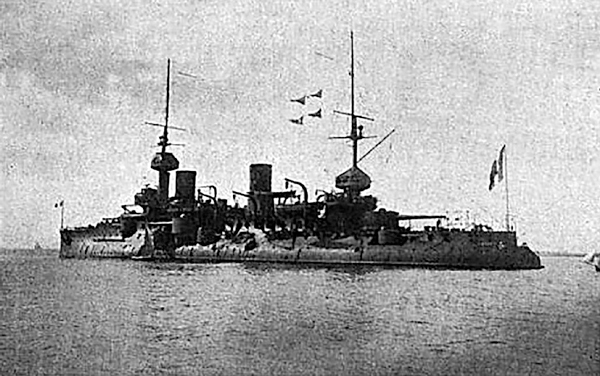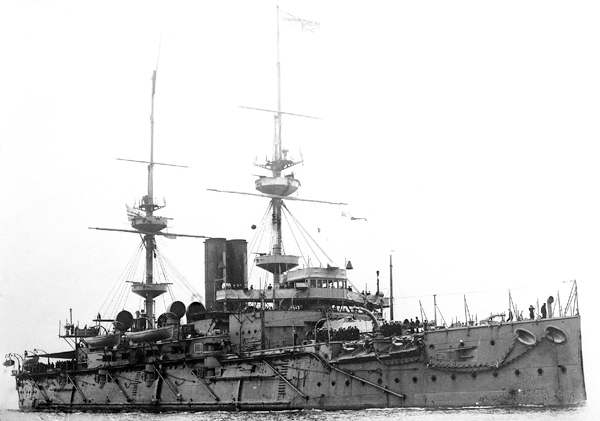
French battleship Bouvet.
E xcept in two instances, the pre-dreadnoughts of all combatant navies were relegated to secondary duties during the war but nevertheless suffered heavy losses. The German Admiral Franz Mauve, commanding the 2nd Battle Squadron of the High Seas Fleet, pleaded for his five Deutschland class to be included in the 1916 sortie which led to the battle of Jutland. There Pommern was torpedoed and lost when her secondary magazine exploded, as it was badly placed and inadequately protected.
The Anglo-French Naval Agreement had envisaged the French fleet remaining in the Mediterranean, but there it was joined by several squadrons of British pre-dreadnoughts; together they formed the fleet for the bold, but eventually disastrous Gallipoli campaign. This, as originally planned, anticipated a naval assault through the Dardanelles to the Bosphorus where, with Constantinople under its guns, the Turks would be forced to surrender and a supply route opened through the Black Sea to Russia. This would inevitably lead to naval losses, but among a category of ships of limited usefulness. When, after a preliminary bombardment of the Turkish positions, the attempt was made to force the passage of the Dardanelles it met with disaster. HMS Ocean and HMS Irresistible were mined; HMS Goliath and HMS Majestic were torpedoed, and the French battleship Bouvet was also mined, sinking in a matter of minutes, while HMS Albion was damaged by shellfire from the forts.
These disasters led to a change of plan, with abortive military landings. Fully alerted, the Turks had ample time to prepare defensive positions and bring in reinforcements. In addition, the new battleship HMS Queen Elizabeth, sent to calibrate her guns, and the battle cruiser HMS Inflexible were quickly removed from the danger zone. There were no further major naval actions in the Mediterranean, but a steady stream of losses.

French battleship Bouvet.
Numbers of the pre-dreadnoughts of the Royal Navy were assigned to the Channel Fleet in 1914, helping to cover the passage of the BEF to France. These included Majestic, Canopus, Venerable, Queen, and Lord Nelson. The remaining Majestic class were all deployed in 1914 as guard ships in the east coast ports, but in 1915 the main armament was removed from Mars, Magnificent, Hannibal and Victorious, and used to equip the new monitors of the General Wolfe class. The disarmed ships were use as troop transports, store ships and depot ships. Illustrious, guard ship for the Tyne and Humber, also became a store ship, while Prince George returned from the Dardanelles to become the depot ship at Chatham. Only two remained in active service in 1918: Caesar in the West Indies, and Jupiter, after use as an icebreaker on the Murmansk route, was sent to the East Indies.

HMS Queen Elizabeth.

HMS Caesar. (© National Maritime Museum, Greenwich, London)
In 1914 the six ships of the Canopus class formed the 8th Battle Squadron, part of the Channel Fleet. Canopus herself was detached to the South American station, where she fired the first shots of the Battle of the Falkland Islands. Glory was stationed first in American and West Indian waters, then in the Mediterranean and finally at Murmansk. The others were all sent to the Dardanelles in 1915, where Ocean was mined and Goliath sunk by torpedo. Vengeance remained as guard ship at Alexandria and Albion returned to home waters and to guard ship duties on the east coast.

Battleship HMS Goliath. (© National Maritime Museum, Greenwich, London)

HMS Ocean in 1900. (Richard Perkins collection, © National Maritime Museum, Greenwich, London)

HMS Formidable.

HMS Irresistible, abandoned and sinking after hitting an exploding mine during the Battle of Gallipoli, 18 March 1915.
Of the next class to be built, Irresistible was mined in the Dardanelles and Formidable sunk by U-24. Implacable survived Gallipoli and served first in the Adriatic and later in the East Indies. Bulwark, of the later London class blew up in 1914 off Sheerness, a victim of unstable cordite; the other four survived not only the Dardanelles but the war itself. In 1917 London was converted to a mine-laying role, while Venerable, Queen and Prince of Wales remained in the Adriatic.
The five remaining ships of the Duncan class (the unfortunate Montagu had been wrecked on Lundy in 1906) formed the 6th Battle Squadron in 1914, and saw extensive service in home waters and in the Mediterranean. Russell was mined and sunk off Malta in 1916, and Cornwallis fell victim to the torpedoes of U-32 the following January, also off Malta. The others, Exmouth, Duncan and Albermarle all survived the war.

HMS Implacable at anchor at Spithead. (© National Maritime Museum, Greenwich, London)
The eight ships of the King Edward VII class (derisively known as the ‘wobbly eight’) formed the 3rd Battle Squadron of the Grand Fleet in 1914, but never saw action as a squadron. In 1916 the name ship was mined off Cape Wrath and two days before the Armistice Britannia was torpedoed by U-50 off Cape Trafalgar. Both ships were lost after lengthy struggles to save them. Hibernia and Zealandia (renamed in 1911 when her original name was transferred to the battle cruiser New Zealand) both survived the Gallipoli operation, while Hindustan was in 1918 the depot ship for the raid on Zeebrugge.
HMS Commonwealth ended her career as a gunnery training ship until, with her five remaining sisters, she was sent to the breakers’ yards in 1921. Lord Nelson and Agamemnon were stationed in the Channel and then in the Mediterranean. The oldest capital ship to fire her guns in the war was the old Revenge of 1892 which, now renamed Redoutable to free her original name for a new ship, bombarded German positions on the Belgian coast in October 1914.

Battleship HMS Bulwark. (© National Maritime Museum, Greenwich, London)

Battleship HMS Queen. (© National Maritime Museum, Greenwich, London)